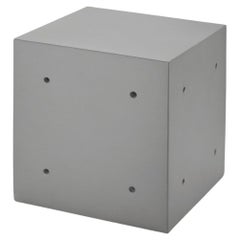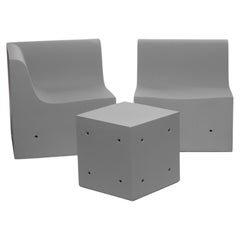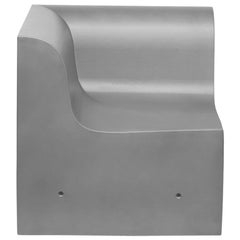Gufram Softcrete
21st Century and Contemporary Italian Modern Chairs
Foam
21st Century and Contemporary Italian Modern Ottomans and Poufs
Foam
21st Century and Contemporary Italian Modern Sectional Sofas
Foam
21st Century and Contemporary Italian Modern Armchairs
Foam
People Also Browsed
21st Century and Contemporary Italian Modern Daybeds
Plastic
Gufram Furniture for sale on 1stDibs
The brainchild of the Fratelli Gugliermetto company, Gufram was born in 1966 in Turin, Italy, massively inspired by the avant-garde artistic culture that reigned in Europe during the 1960s and '70s. The brand is known for its CACTUS coat stand and sculptural seating such as the Pratone chair as well as other massive, innovative pieces that fall somewhere between art and furniture.
Starting in the mid-1960s, proponents of Italian Radical Design — which included forward-looking collectives like Archizoom and Studio 65 — broke with formality and convention by fusing the joy of Pop art with the systems of mass production.
One of the brands that formed as a result of these experiments was Gufram, a manufacturer at the forefront of the country’s Radical Design movement. The Gugliermetto brothers teamed up with emerging artists to harness exciting new materials — among them, polyurethane foam, which was originally used in the transportation industry as insulation to keep buses and trains warm.
Despite being credited for revolutionizing Italian design, until the mid-1970s, Gufram was largely unknown outside the small Italian town where it was founded. Nearly six years after the brand’s inception, though, word got out about a furniture brand transforming polyurethane foam into gigantic works of art. So, Gufram brought its playful and witty design concept across the Atlantic to New York’s Museum of Modern Art, where it had its first international show.
Gufram produced much of the Pop furniture — the CACTUS coat rack by Guido Drocco and Franco Mello and the Bocca sofa, in the shape of big red lips, by Studio 65 — that came to define the Anti-Design movement. (Through a relationship with Gufram, the latter was imported to the United States by Charles Stendig, a collector and pioneering importer who helped spark America’s interest in furniture from Finland, Switzerland and Italy during the 1960s and ‘70s.)
Although furniture can be serious business, it’s just as often playful, provocative, energizing and even liberating. Perhaps nothing embodies these characteristics better than postmodern Italian design. And one of the most iconic pieces to originate during Italy’s fertile period of postmodern furniture design is the Pratone chair, designed in 1971 by Giorgio Ceretti, Piero Derossi and Riccardo Rosso.
Representing a magnified portion of a grassy meadow, the Pratone chaise provides a lounging place for an individual or a group. “It is so unlike anything else that it stands out and is still iconic after 50 years,” said Charley Vezza, Gufram’s global creative orchestrator.
Made of painted polyurethane foam, the Pratone chair immediately became the symbol of a new and different approach to interiors when it debuted.
Gufram has become a favorite of the international art crowd and glitterati, and its products have made their way to the world’s most renowned museums, including the Metropolitan Museum of Art, Vitra Design Museum and more.
British fashion designer Paul Smith and American multi-hyphenate artist A$AP Rocky have collaborated with Gufram over the years. Interior designer Tony Ingrao has called the Pratone chair one of his favorite works and featured the larger-than-life piece in an exhibition he curated at R & Company in 2016.
Find new and vintage Gufram chairs, sofas, mirrors and other Gufram furniture for sale on 1stDibs.
A Close Look at Modern Furniture
The late 19th and early 20th centuries saw sweeping social change and major scientific advances — both of which contributed to a new aesthetic: modernism. Rejecting the rigidity of Victorian artistic conventions, modernists sought a new means of expression. References to the natural world and ornate classical embellishments gave way to the sleek simplicity of the Machine Age. Architect Philip Johnson characterized the hallmarks of modernism as “machine-like simplicity, smoothness or surface [and] avoidance of ornament.”
Early practitioners of modernist design include the De Stijl (“The Style”) group, founded in the Netherlands in 1917, and the Bauhaus School, founded two years later in Germany.
Followers of both groups produced sleek, spare designs — many of which became icons of daily life in the 20th century. The modernists rejected both natural and historical references and relied primarily on industrial materials such as metal, glass, plywood, and, later, plastics. While Bauhaus principals Marcel Breuer and Ludwig Mies van der Rohe created furniture from mass-produced, chrome-plated steel, American visionaries like Charles and Ray Eames worked in materials as novel as molded plywood and fiberglass. Today, Breuer’s Wassily chair, Mies van der Rohe’s Barcelona chair — crafted with his romantic partner, designer Lilly Reich — and the Eames lounge chair are emblems of progressive design and vintage originals are prized cornerstones of collections.
It’s difficult to overstate the influence that modernism continues to wield over designers and architects — and equally difficult to overstate how revolutionary it was when it first appeared a century ago. But because modernist furniture designs are so simple, they can blend in seamlessly with just about any type of décor. Don’t overlook them.
Finding the Right Sectional-sofas for You
An antique, new or vintage sectional sofa is a versatile and practical style of seating that makes for a great addition to your living space.
A traditional sofa is typically a long upholstered seat that features a back and arms and is intended for two or more people, whereas a sectional sofa consists of multiple pieces that can be arranged in several different layouts. While a conventional couch or sofa can definitely seat a fixed number of houseguests, sectional sofas allow for customizing. We all know that maximizing your square footage in a small space can prove difficult, so the modular characteristics of sectional sofas are especially appealing when you’re thinking about design ideas for your modest-sized living room. This furnishing can be arranged in a semicircle, an L-shape or other configuration and will seat more people than a standard sofa will.
When it comes to home decor, the trick is to find a balance between functionality and style. Sectional sofas are available in a wide variety of shapes, sizes, colors and fabric options, so you’re sure to find one that perfectly complements your interiors and needs. But there are several factors to consider when choosing the perfect sectional sofa for your space.
According to Charleston designer Angie Hranowsky, “the most important thing to know when choosing the perfect sofa is its purpose. Is it for conversation or for watching TV and lounging? Then you can determine the right depth and seat height.”
The size of your sectional sofa will depend on how much real estate you’re working with in your living room and exactly how you use the space. If you’re trying to define a common area in your sprawling loft apartment or you’ve got a large family to think about, a large, sleek contemporary sectional or sculptural sectional sofa designed by Milo Baughman, say, could be ideal for comfort as well as a conversation piece, particularly if you intend to entertain with regularity. Think about seat height and depth — high seats, for example, can yield an air of formality that might not be a great fit for your crowd.
For movie nights, holiday parties or the occasional but totally fabulous dinner party, a large sectional sofa means getting multiple uses out of a singular piece of seating. In smaller rooms, it might make sense to position your small sectional sofa against the wall, whereas in a wide-open space, the sofa’s components can occupy the center of the room. Measure accordingly and make sure your doorways can accommodate on delivery day.
Bring comfort and class to your living space with a sectional sofa from the world’s best dealers on 1stDibs. For your mid-century modern-inspired living room, find fun spage-age sectional sofas, chic leather sectional sofas and a range of vintage mid-century sectional sofas designed by the likes of Harvey Probber, Vladimir Kagan and others.



